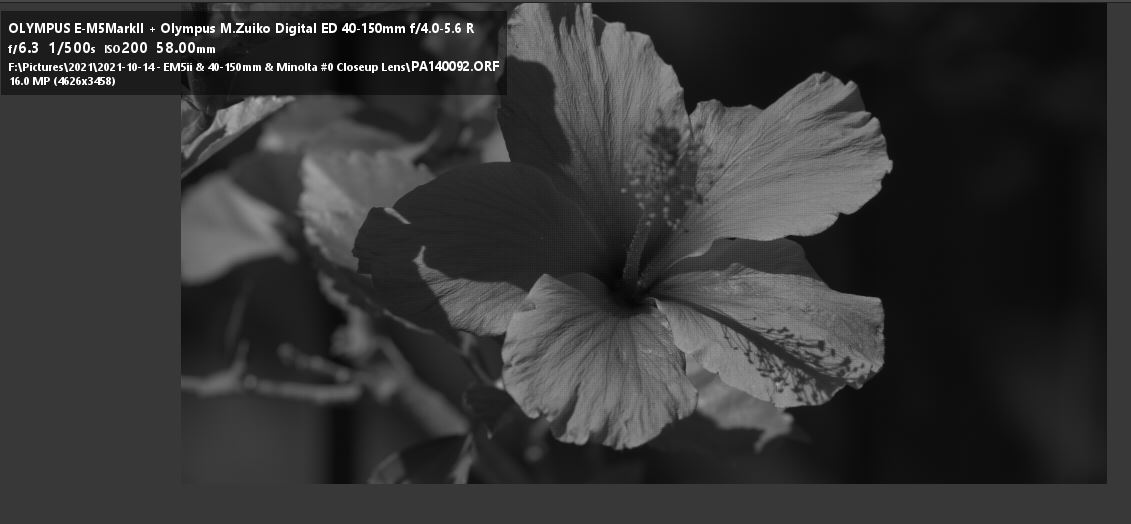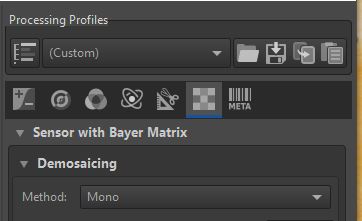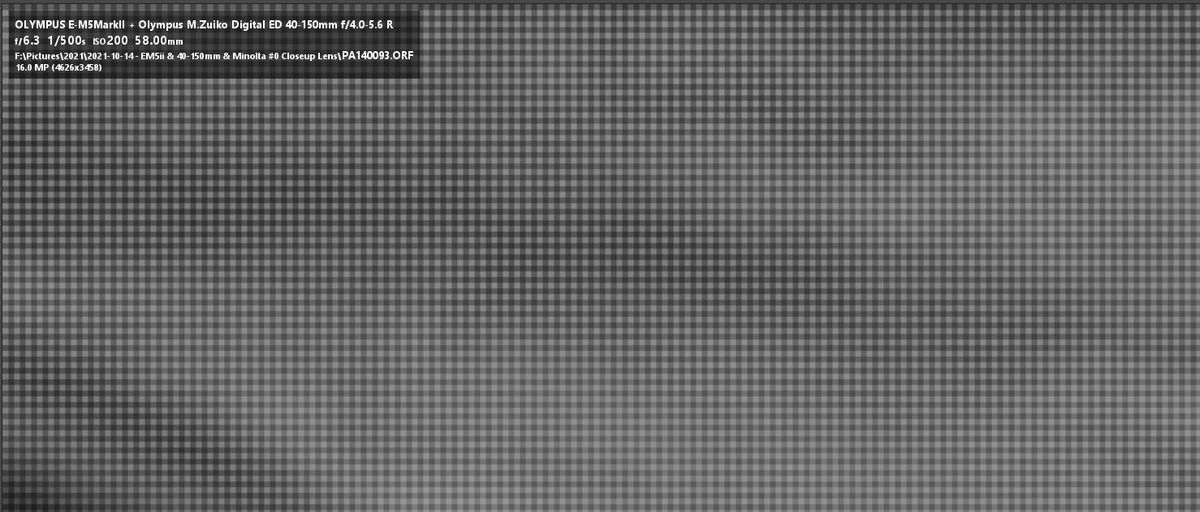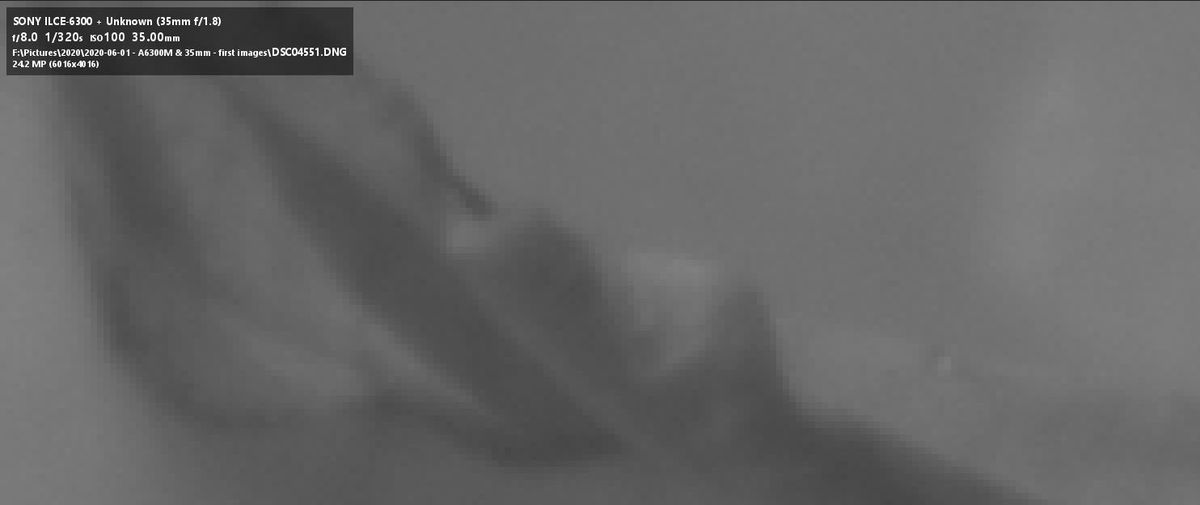D90 IR Conversion
Feb 16, 2022 13:20:23 #
larryepage
Loc: North Texas area
elee950021 wrote:
If you have an older lens for a film camera, there... (show quote)
All understood. This camera came to me as the byproduct of a discussion to understand why it wouldn't take "regular pictures." It was part of a package purchased by another member at a thrift store. That package included some items I had been looking for, so I bought it. The camera was initially just an "extra" to me. It's developed into more than that. We know nothing of the history of the camera, but I will eventually be pursuing it. The one thing that is absolutely clear is that it is not a full spectrum conversion.
Feb 16, 2022 13:23:25 #
Chan Garrett wrote:
The way professional conversion is done is to tota... (show quote)
It is also possible use the free App RawTherapee to see if the camera still has the CFA.
Follow these steps:
Image 1. Load a RAW file. It has to be a RAW file. A JPEG won't work. If demosaicing has already been done it won't work.
Image 2. Find the setting to choose the demosaicing method. One of the choices is mono. Choose that.
Image 3. Expand it real big, preferably on an area of constant color. It will look like a checkerboard. Some are due to the effect of a red filter, some due to a green filter and some to a blue filter.
Image 4. A real mono RAW file.
If there is no checkerboard, then there is no CFA. It's been removed.
select a RAW file

Select mono for demosaicing

checkerboard from RAW with CFA

(Download)
mono RAW

(Download)
Feb 16, 2022 13:23:34 #
CHG_CANON wrote:
Have you determined why the image is not in focus?
Focus is always an issue for DSLR’s converted for IR. Usually when you get a DSLR converted you also include the lens you plan on using with it so they can calibrate it to focus. This is another place where mirrorless really shines. I can use any of my M4/3 lenses with my full spectrum converted Lumix GH2. Although I wonder if the newer hybrid focusing mirrorless might have trouble.
Feb 16, 2022 13:39:23 #
SuperflyTNT wrote:
Focus is always an issue for DSLR’s converted for IR. Usually when you get a DSLR converted you also include the lens you plan on using with it so they can calibrate it to focus. This is another place where mirrorless really shines. I can use any of my M4/3 lenses with my full spectrum converted Lumix GH2. Although I wonder if the newer hybrid focusing mirrorless might have trouble.
This is correct. But some DSLR might be easier to manually focus than others.
But mirrorless is the way to go. My full spectrum Olympus EM5ii is an absolute joy to use, and manual focus is so easy and accurate. I have many manual lenses I like to use with it. But with AF lenses, it nails it also. I have about 6 m4/3 lenses, and they all autofocus perfectly with it. There is zero need to have the camera calibrated with a particular lens. If it will autofocus, it will be right on.
I also have an older Sony A55 which is a SLT type camera with a Translucent Mirror. It thinks it is auto focusing. But the IR difference makes it also miss real focus. But it has live view similar to what a mirrorless has, and manually focusing it is rather easy. But since I have the EM5ii now, this camera does't get used very often.
Feb 16, 2022 15:54:39 #
larryepage wrote:
Of course, it is possible that the filter is still there...no way to visually verify with the IR filter in place. It is certainly possible that the deep IR cutoff just renders it totally ineffective. In any case, there is no color content evident in anything coming from the sensor. Color histograms follow each other in all cases unless shifted by WB adjustments. (I may have extrapolated and over-inferred.)
Just checking; Maybe I misread. Thought you indicated it was gone. There is apparently a color difference in the sensor, but then you would need the filter out to see. The histograms would of course, thinking on it, sensore would just think red is green, like it would for true mono conversion.
Have a good day;
Feb 16, 2022 18:33:14 #
larryepage wrote:
Of course, it is possible that the filter is still there...no way to visually verify with the IR filter in place. It is certainly possible that the deep IR cutoff just renders it totally ineffective. In any case, there is no color content evident in anything coming from the sensor. Color histograms follow each other in all cases unless shifted by WB adjustments. (I may have extrapolated and over-inferred.)
Take a look at the example I posted using RawTherapee to determine if a CFA is present or not. It won't matter what IR filter is present. Just load a RAW file into RawTherapee. Then for the demosaicing, select mono. And finally, make the image big enough to see the pixels. If you see checkerboarding, the CFA is present.
As for what IR filter is on it, take a picture in RAW and then export as a JPEG and see what color it is. Make sure the camera is not set to B&W mode. Use Sunny WB. Attached are two examples. Is it more like the 720 nm filter (a reddish color) or the 850 nm filter (more violet color)? This works for me when I forget to make note of what filter I used, and I can look at this result and see what its closest too.
As for using filters, if you know the filter wavelength, you can always go longer and change the behavior. But you can't go shorter.
The 3rd image is what I get using the Sony A6300 with a 720nm filter. And I captured in RAW and opened in Lightroom (which converted it to RGB along with demosaicing) and then exported to JPEG. The sensor has no CFA filters. But the camera doesn't know it's a mono sensor with no CFA. With the camera in color mode (not B&W), it thinks this is the color of the image based on what it would be based on the values of the previously filtered pixels.
Try these tricks and let's see if we can identify your filter wavelength and whether or not it has a CFA.
Feb 16, 2022 18:47:33 #
larryepage
Loc: North Texas area
JimH123 wrote:
Take a look at the example I posted using RawThera... (show quote)
I will try what you suggest. Be patient, please, it may be a few days. Lots of "real life" priorities competing right now...
If you want to reply, then register here. Registration is free and your account is created instantly, so you can post right away.




